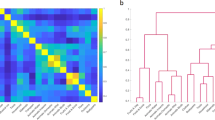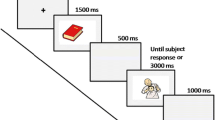Summary
The semantic-priming paradigm was used to investigate the effect of semantic context on the latency to identify visually ambiguous and unambiguous targets. Ambiguous targets had reversible figure-ground organizations analogous to Rubin's vase-profiles picture in which the figural vase is shaped by the same contour that, if reassigned, shapes two figural profiles. The two organizations of the ambiguous targets were either a series of black irregular shapes or a familiar word in white letters; subjects were required to achieve the latter organization. Unambiguous target words were not reversible. Related primes, unlike unrelated primes, facilitated the identification of both types of target; but the magnitude of facilitation was greater for ambiguous targets. The results demonstrate that semantic context influences the speed of figure-ground organization and add perceptual ambiguity to the target manipulations that interact with context to affect encoding.
Similar content being viewed by others
References
Becker, C. A., & Killion, T. H. (1977). Interaction of visual and cognitive effects in word recognition.Journal of Experimental Psychology: Human Perception and Performance, 3, 389–401.
Bridgeman, B. (1981). Cognitive factors in subjective stabilization of the visual world.Acta Psychologica, 48, 111–121.
Clark, H. H. (1973). The language-as-fixed-effect fallacy: A critique of language statistics in psychological research.Journal of Verbal Learning and Verbal Behavior, 12, 335–359.
Klymenko, V., & Weisstein, N. (1986). Spatial frequency differences can determine figure-ground organization.Journal of Experimental Psychology: Human. Perception and Performance, 12, 324–330.
Klymenko, V., Weisstein, N., Topolski, R., & Hsieh, C. (1989). Spatial and temporal frequency in figure-ground organization.Perception & Psychophysics, 45, 395–403.
Meyer, D. E., Schvaneveldt, R. W., & Ruddy, M. G (1975). Loci of contextual effects on visual word recognition. In P. M. A. Rabbitt & S. Dornic (Eds.),Attention and performance (Vol. V). New York: Academic Press.
Owen, L. A. (1985). The effect of masked pictures on the interpretation of ambiguous pictures.Current Psychological Research and Reviews, 4, 108–118.
Palermo, D. S., & Jenkins, J. J. (1964).Word association norms. Minneapolis: University of Minnesota Press.
Pomerantz, J. R., & Kubovy, M. (1986). Theoretical approaches to perceptual organization. In K. R. Boff, L. Kaufman, & J. P. Thomas (Eds.),Handbook of perception and human performance (Vol. II).Cognitive processes and performance. New York: Wiley.
Rock, I. (1986). The description and analysis of object and event perception. In K. R. Boff, L. Kaufman, & J. P. Thomas (Eds.),Handbook of perception and human performance (Vol. II).Cognitive processes and performance. New York: Wiley.
Rubin, E. (1921/1958). Visuell wahrgenommene Figuren. Translated by D. C. Beardslee & M. Wertheimer (Eds.),Readings in psychology. Princeton, NJ: D. Van Nostrand.
Schvaneveldt, R. W., & McDonald, J. E. (1981). Semantic context and the encoding of words: Evidence for two modes of stimulus analysis.Journal of Experimental Psychology: Human Perception and Performance, 7, 673–687.
Schvaneveldt, R. W., & Meyer, D. E. (1973). Retrieval and comparison processes in semantic memory. In S. Kornblum (Ed.),Attention and Performance (Vol. IV). New York: Academic Press.
Sternberg, S. (1969). The discovery of processing stages: Extensions of Donders' method. In W. E. Koster (Ed.),Attention and Performance (Vol II). Amsterdam: North-Holland.
Uttal, W. R. (1981).A taxonomy of visual processes. Hillsdale, NJ: Erlbaum.
Weitzman, B. (1963). A threshold difference produced by a figureground dichotomy.Journal of Experimental Psychology, 66, 201–205.
Wong, E., & Weisstein, N. (1982). Anew perceptual context-superiority effect: Line segments are more visible against a figure than against a ground.Science, 218, 587–589.
Wong, E., & Weisstein, N. (1983). Sharp targets are detected better against a figure, and blurred targets are detected better against a background.Journal of Experimental Psychology: Human Perception and Performance, 9, 194–202.
Wong, E., & Weisstein, N. (1987). The effects of flicker on the perception of figure and ground.Perception & Psychophysics, 41, 440–448.
Zusne, L. (1970).Visual perception of form. New York: Academic Press.
Author information
Authors and Affiliations
Rights and permissions
About this article
Cite this article
Davis, J., Schiffman, H.R. & Greist-Bousquet, S. Semantic context and figure-ground organization. Psychol. Res 52, 306–309 (1990). https://doi.org/10.1007/BF00868062
Received:
Accepted:
Issue Date:
DOI: https://doi.org/10.1007/BF00868062




